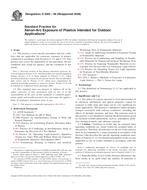Potřebujeme váš souhlas k využití jednotlivých dat, aby se vám mimo jiné mohly ukazovat informace týkající se vašich zájmů. Souhlas udělíte kliknutím na tlačítko „OK“.
ASTM D2565-99(2008)
Standard Practice for Xenon-Arc Exposure of Plastics Intended for Outdoor Applications
Automaticky přeložený název:
Standardní praktiky pro Xenon-Arc Expozice plastech určených pro venkovní použití
NORMA vydána dne 1.3.2008
Informace o normě:
Označení normy: ASTM D2565-99(2008)
Poznámka: NEPLATNÁ
Datum vydání normy: 1.3.2008
Kód zboží: NS-20762
Počet stran: 4
Přibližná hmotnost: 12 g (0.03 liber)
Země: Americká technická norma
Kategorie: Technické normy ASTM
Kategorie - podobné normy:
Anotace textu normy ASTM D2565-99(2008) :
Keywords:
degradation, exposure, light exposure, ultraviolet, xenon-arc, Degradation--plastics, Exposure tests--plastics, Light exposure--plastics, Ultraviolet (UV) analysis--plastics, Water exposure apparatus, Xenon-arc light exposure, ICS Number Code 83.140.01 (Rubber and plastic products in general)
Doplňující informace
| Significance and Use | ||||||||||||||||||||||||
|
The ability of a plastic material to resist deterioration of its electrical, mechanical, and optical properties caused by exposure to light, heat, and water can be very significant for many applications. This practice is intended to induce property changes associated with end-use conditions, including the effects of daylight, moisture, and heat. The exposure used in this practice is not intended to simulate the deterioration caused by localized weather phenomena, such as, atmospheric pollution, biological attack, and saltwater exposure. Caution—Variations in results may be expected when operating conditions are varied within the accepted limits of this practice. Therefore, all references to the use of this practice must be accompanied by a report prepared in accordance with Section 9 that describes the specific operating conditions used. Refer to Practice G 151 for detailed information on the caveats applicable to use of results obtained in accordance with this practice. Note 3—Additional information on sources of variability and on strategies for addressing variability in the design, execution, and data analysis of laboratory-accelerated exposure tests is found in Guide G 141. Reproducibility of test results between laboratories has been shown to be good when the stability of materials is evaluated in terms of performance ranking compared to other materials or to a control. , Therefore, exposure of a similar material of known performance (a control) at the same time as the test materials is strongly recommended. It is recommended that at least three replicates of each material be exposed to allow for statistical evaluation of results. Test results will depend upon the care that is taken to operate the equipment in accordance with Practice G 155. Significant factors include regulation of line voltage, freedom from salts or other deposits from water, temperature and humidity control, and condition and age of the burner and filters. |
||||||||||||||||||||||||
| 1. Scope | ||||||||||||||||||||||||
|
1.1 This practice covers specific procedures and test conditions that are applicable for xenon-arc exposure of plastics conducted in accordance with Practices G 151 and G 155. This practice also covers the preparation of test specimens, the test conditions best suited for plastics, and the evaluation of test results. Note 1—Previous versions of this practice referenced xenon-arc devices described in Practice G 26, which described very specific equipment designs. Practice G 26 is being replaced by Practice G 151, which describes performance criteria for all exposure devices that use laboratory light sources and by Practice G 155, which gives requirements for exposing nonmetallic materials in xenon-arc devices. Practice G 26 will be balloted for withdrawal before December 2000. 1.2 This standard does not purport to address all of the safety concerns, if any, associated with its use. It is the responsibility of the user of this standard to establish appropriate safety and health practices and determine the applicability of regulatory limitations prior to use. Note 2—This practice is technically equivalent to ISO 4892-2. |
||||||||||||||||||||||||
| 2. Referenced Documents | ||||||||||||||||||||||||
|




 Cookies
Cookies
